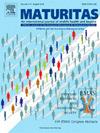围绝经期和绝经后妇女口干和口腔健康相关生活质量
IF 3.6
2区 医学
Q2 GERIATRICS & GERONTOLOGY
引用次数: 0
摘要
目的绝经期的过渡会引发激素的变化,从而表现为口腔症状,如口干症,这会严重影响女性的生活质量。我们的研究调查了口干症的患病率和严重程度及其与绝经状态的关系。此外,我们评估了口干症对围绝经期和绝经后妇女口腔健康相关生活质量的影响。方法本研究是基于REDCap调查结果的横断面调查,涉及3211名年龄在40至90岁之间的女性。调查记录了年龄、绝经状况、绝经年龄、吸烟状况和是否接受过致干性药物治疗,包括两种工具:用于评估口腔症状的口干性量表;以及用于评估相关生活质量的口腔健康影响概况-14 (OHIP-14)。采用学生t检验、卡方检验、Pearson相关系数、多变量logistic回归和线性回归进行数据分析。比值比(OR)、β系数(β)及其95%置信区间(CIs)用于评估相关性。结果全球口干症患病率为71.2%。口腔干燥量表评分与OHIP-14评分相关(r = 0.686;p = 0.000)。吸烟与口干的可能性显著相关(OR = 1.36;95% CI = 1.02-1.82),以下OHIP-14域也是如此:功能限制(OR = 1.43;95% CI = 1.30-1.50),身体疼痛(OR = 1.17;95% CI = 1.06-1.29),心理不适(OR = 1.21;95% CI = 1.13-1.29),身体残疾(OR = 1.11;95% CI = 1.02-1.20),心理障碍(OR = 1.18;95% CI = 1.09-1.29),社会残疾(OR = 1.15;95% ci = 1.01-1.32)。根据绝经状态,发生口干的可能性无显著差异。有口干症的妇女OHIP-14评分高于无口干症的妇女(β = 5.50;95% ci = 4.69-6.31)。结论绝经期及绝经后妇女口干症患病率较高。围绝经期和绝经后妇女发生口干的可能性没有差异。口腔干燥症状与口腔健康相关的生活质量差之间有很强的联系。本文章由计算机程序翻译,如有差异,请以英文原文为准。
Xerostomia and oral health-related quality of life in peri- and postmenopausal women
Objective
The menopausal transition triggers hormonal changes that can manifest in oral symptoms such as xerostomia, which can substantially impact women's quality of life. Our study examined the prevalence and severity of xerostomia and its association with menopausal status. Furthermore, we evaluated the impact of xerostomia on oral health-related quality of life in peri- and postmenopausal women.
Methods
This study was a cross-sectional investigation based on the results of a REDCap survey, involving 3211 women aged between 40 and 90 years. The survey recorded age, menopause status, age at menopause, smoking status, and being treated with xerogenic drugs and included two instruments: the Xerostomia Inventory, used to evaluate the oral symptoms; and the Oral Health Impact Profile-14 (OHIP-14), used to assess the related quality of life. Student's t-test, the chi-squared test, Pearson's correlation coefficient, and multivariable logistic and linear regressions were performed for data analysis. Odds ratio (OR), beta coefficient (β), and their 95 % confidence intervals (CIs) were applied to assess associations.
Results
The global prevalence of xerostomia was 71.2 %. The Xerostomia Inventory score correlated with the OHIP-14 score (r = 0.686; p = 0.000). Smoking was significantly associated with the probability of xerostomia (OR = 1.36; 95 % CI = 1.02–1.82), as were the following OHIP-14 domains: functional limitation (OR = 1.43; 95 % CI = 1.30–1.50), physical pain (OR = 1.17; 95 % CI = 1.06–1.29), psychological discomfort (OR = 1.21; 95 % CI = 1.13–1.29), physical disability (OR = 1.11; 95 % CI = 1.02–1.20), psychological disability (OR = 1.18; 95 % CI = 1.09–1.29), and social disability (OR = 1.15; 95 % CI = 1.01–1.32). There were no significant differences in the probability of xerostomia according to the menopausal status. In women with xerostomia the OHIP-14 score was higher than in women without xerostomia (β = 5.50; 95 % CI = 4.69–6.31).
Conclusions
Peri- and postmenopausal women have a high prevalence of xerostomia. There were no differences in the probability of xerostomia between peri- and postmenopausal women. There was a strong association between xerostomia symptoms and poor oral health-related quality of life.
求助全文
通过发布文献求助,成功后即可免费获取论文全文。
去求助
来源期刊

Maturitas
医学-妇产科学
CiteScore
9.10
自引率
2.00%
发文量
142
审稿时长
40 days
期刊介绍:
Maturitas is an international multidisciplinary peer reviewed scientific journal of midlife health and beyond publishing original research, reviews, consensus statements and guidelines, and mini-reviews. The journal provides a forum for all aspects of postreproductive health in both genders ranging from basic science to health and social care.
Topic areas include:• Aging• Alternative and Complementary medicines• Arthritis and Bone Health• Cancer• Cardiovascular Health• Cognitive and Physical Functioning• Epidemiology, health and social care• Gynecology/ Reproductive Endocrinology• Nutrition/ Obesity Diabetes/ Metabolic Syndrome• Menopause, Ovarian Aging• Mental Health• Pharmacology• Sexuality• Quality of Life
 求助内容:
求助内容: 应助结果提醒方式:
应助结果提醒方式:


